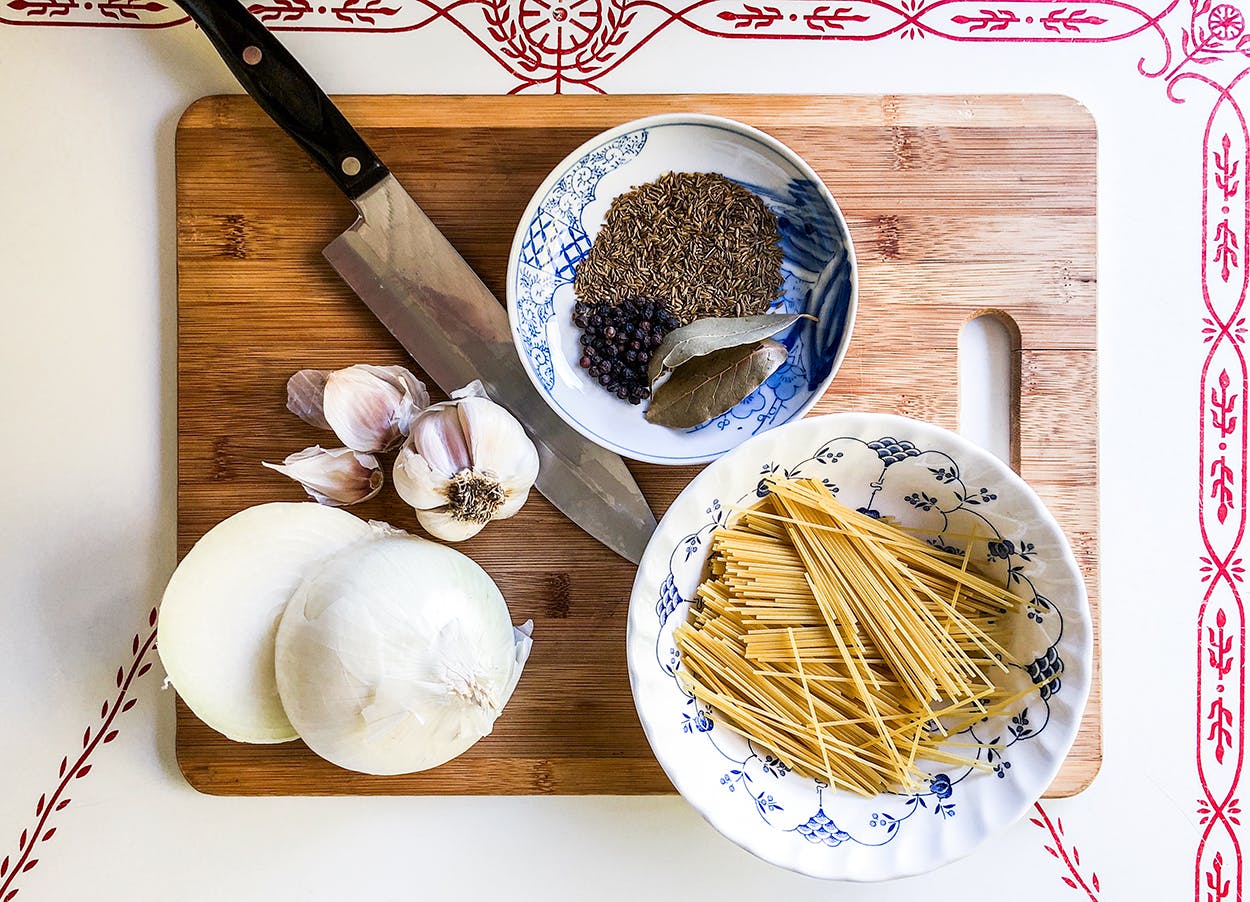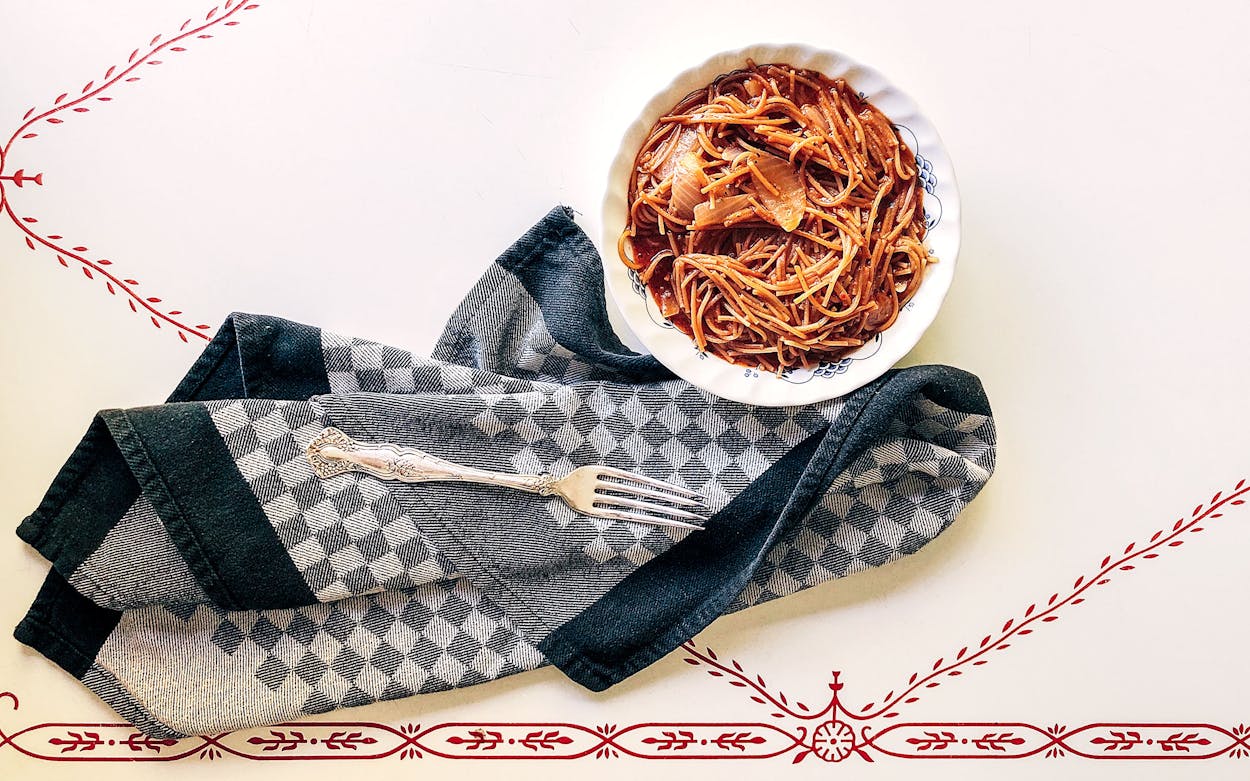To make a good fideo, you need three things: meat, a molcajete, and vermicelli noodles. In Harlingen, where I grew up, the preferred option was bone-in chicken legs, salted and fried in a pan shimmering with hot oil, just enough so that the skin was crackling and sticky and the juices runny. In the summer heat, with a chorus of cicadas humming in the chinaberry trees, my mother would smash a garlic clove with a handful of cumin seeds and black peppercorns with the mortar of her mother’s molcajete (a mortar and pestle made of lava rock) to make the paste from which the fideo would absorb its flavor, like a blooming rose. She’d fry a big Spanish onion in a smattering of chicken grease and swish in the paste. It would sizzle in the pan, and soon enough the kitchen would smell fragrant, exotic, a perfume unlike anything else in the bright, white-hot world of high grasses I grew up in.
Fideo is the simplest of all Tex-Mex dishes: a protein (usually chicken or beef) served with heavily seasoned, dry-fried vermicelli noodles, usually served with pinto beans. In the communities of South Texas, fideo is synonymous with the boredom of summertime. It’s a dish you eat at lunch in the hot blue noons of a Texan summer, your hands sticky with the velouté–like sauce of tomato, pepper, cumin, and garlic, the slinky, thin, dry-fried noodles plump with sauce and begging to be spooned into a corn tortilla. I never saw it made anywhere but in people’s houses—nobody I knew brought it to church suppers or barbecues or birthday parties. Fideo is a dish to be savored only in the sumptuous privacy of one’s home.
I knew fideo was coming when the kitchen smelled of cumin and garlic. Mom would ask me to get the tortillas. I would pull myself away from my book of saints’ lives or, in the summer of 1995, the O.J. Simpson trial, and head down F Street in Harlingen to Tortillería Las Güeras to pick up a pack of freshly made corn tortillas. As I walked home in triple-digit heat, I would hold the paper bag close to me, anticipating the magnificent moment when I could open it and inhale a cloud of hot steam rich with the scent of masa harina—the tortillas, you see, were solely for the fideo, and nothing else. That afternoon, we would eat fideo with corn tortillas on flat Corningware plates with the same ditsy pattern, served with a can of Ranch Style beans. My grandfather would fish out a pickled jalapeño from a jar and squeeze the juice over the entire dish. Best accompanied by reruns of old films on Mexican TV, the dish was a gateway drug of Mexican cuisine. No one else could own it: New Mexicans had their chimichangas and Christmas chili, San Antonians had their enchiladas suizas, but fideo was all South Texas, as authentic as a heat stroke at South Padre Island.

But now I live in Portland, Oregon, and making fideo is not as easy as it was. When I can find it here, hipsters have fancified it with braised beef, with wasabi, with corn smuts from central Mexico called huitlacoches. But for the real thing, you can’t overcomplicate fideo. So, after a rough day at work, hankering for a consoling meal from home, I set out to make it myself, nearly ten years since I’d eaten the dish.
First, I had to find the vermicelli. I needed authentic noodles to make the quintessential fideo: Q&Q, with its bright yellow box and its mid-century stylings and its haystack of noodles. I looked for it everywhere in Portland, far from the reliable H-E-B in Harlingen: in a Whole Foods teeming with urban elites, in a Safeway among jars of chicken tikka masala sauce and Korean kalbi marinade. I took a train out about ten miles east from downtown Portland, and in a small market in a strip mall, I found one solitary box of fideo noodles. The lady working the counter, who had recently arrived from Mexico, asked me if I knew how to make fideo at home. I said yes, and then she added, almost without delay, “But you have to learn not to undercook the noodles, OK?”
“It’s true, mi’jito, you have to make sure you cook the noodles right or else they’ll turn out mushy,” my mom said to me that evening. You can’t undercook them or overcook them, she continued. Instead you watch for the tell-tale colorations to appear. The strands of noodles change from blond to brunette in gradations; what you have left is a perfumed, ombré dream.
I bought the noodles and resolved to cook them just like Mom used to make. I called her on FaceTime, and over video streaming from the very same home where she and I grew up—the same house my great-grandfather and grandfather had died in, one of the first houses in our neighborhood—Mom gently guided me through the recipe her mother had passed down to her, pleasantly surprised to find out that I wanted to continue the family tradition. I followed her instructions carefully: the onion must be pan-fried to translucency, the spices finely ground into a paste mixed with water, and the meat must be cooked first, lest it overcook the noodles. As the cloud of spice paste filled my cold little Oregon kitchen with familiar warmth, I remembered the light and dust of the South Texas I knew: the humidity, the smell of the inky sea breeze that turned a still, hot Harlingen afternoon into a luscious, rainy paradise. I tasted the fideo that was served to my late grandfather while he watched reruns of Jerry Springer, the fideo that was served the day of the Reagan funeral, the meager fideo I made with nearly expired boxes of Q&Q during the passage of Hurricane Dolly. The dinner was almost always satisfying, almost always consoling. There is a proverb in Spanish that goes, las penas con pan son menos, “all griefs with bread are less.” Whoever composed that proverb must have been thinking of the feeling of eating fideo.


My mother is insistent that fideo is not the same as the more widely known sopa de fideos. In fact, real fideo always falls somewhere in between a soup and a stew—not too thick, not too thin. It takes vigilance and care to make sure to make this very simple dish of the Tejano people doesn’t turn out to be a grand disappointment. Like all great homemade dishes, fideo transforms simple ingredients into a resplendent complex involuntary memory, triggered by the dry-frying, the sizzle of the water added to the pan, the simmering, the seasoning. The fragrant steam arising from fideo offers glimpses of the dish’s origins: the cumin from India, the onion fields, the chilies from Durango or Sinaloa, the carnicero’s cuts of beef or chicken, the shack on the South Texas plain where it was first served to families returning from the fields in the humid, oppressive evening. To make fideo is to conjure up these worlds again, and to eat it is to relive, in some tangible way, the gentle comforts of home and history.
Joe Galván’s Family Fideo
Serves 4
2 teaspoons of olive oil or canola oil
about 8 ounces of protein (either boneless, skinless chicken, cubed chicken, or chicken legs)
1/4 teaspoon of cumin seeds
2 cloves of minced garlic
1/4 teaspoon of black peppercorn
1 cup of finely diced onion
1 box of fideo noodles (preferably Q&Q Vermicelli)
about 2 cups of chicken stock
1 can of tomato sauce or 1/2 can of tomato paste
1 bay leaf (preferably a Mexican bay laurel leaf)
salt and pepper to taste
Optional:
1 diced green bell pepper
1/8 to 1/4 teaspoon of chili powder or cayenne
jalapeños to taste
In a frying pan, sauté chicken seasoned with salt and pepper until the chicken is lightly browned on all sides but not entirely cooked. If you’re using bone-in chicken, brown the chicken sufficiently so that the skin is consistently brown and sticky. Set aside.
In a molcajete or a mortar and pestle (or using a Cuisinart), process cumin, black peppercorns, and garlic until it forms a paste.
Pour off all but 2 tablespoons of chicken grease, or add 2 tablespoons of oil. Sauté the onion (and an optional green bell pepper) over medium-high heat until translucent. While the onion is cooking, add the spice paste into the onions and continue sautéing until the mixture is fragrant.
Immediately add the vermicelli noodles and lower the heat to medium. Continue to stir-fry the noodles in the onion-spice paste mix until the noodles change color from a light to medium blonde color. Be careful not to scorch the noodles so they don’t become bitter.
Add the chicken and the chicken stock. The chicken stock will sizzle upon hitting the hot oil, so be gentle. Add the tomato sauce or paste and the bay leaf. Heat to boiling, then lower the flame to very low heat. Cover.
Simmer for 10 to 15 minutes, until the noodles have softened considerably. Take care that the noodles don’t dissolve: Each strand should have the consistency of al dente pasta. The dish should have the consistency of a thin stew. The chicken, if it is bone-in, should have its juices run clear to an internal temperature of 165º F.
Remove the bay leaf. Serve with pinto beans and hot corn tortillas.






